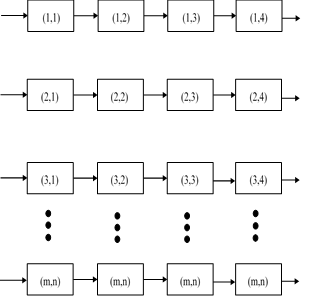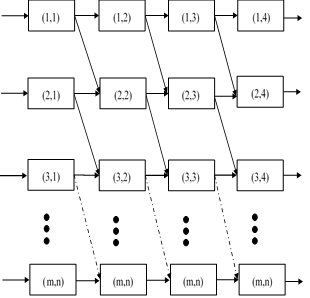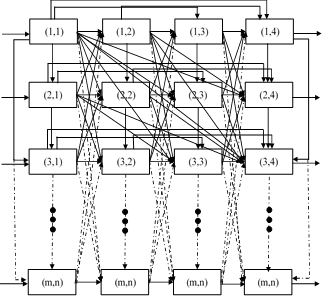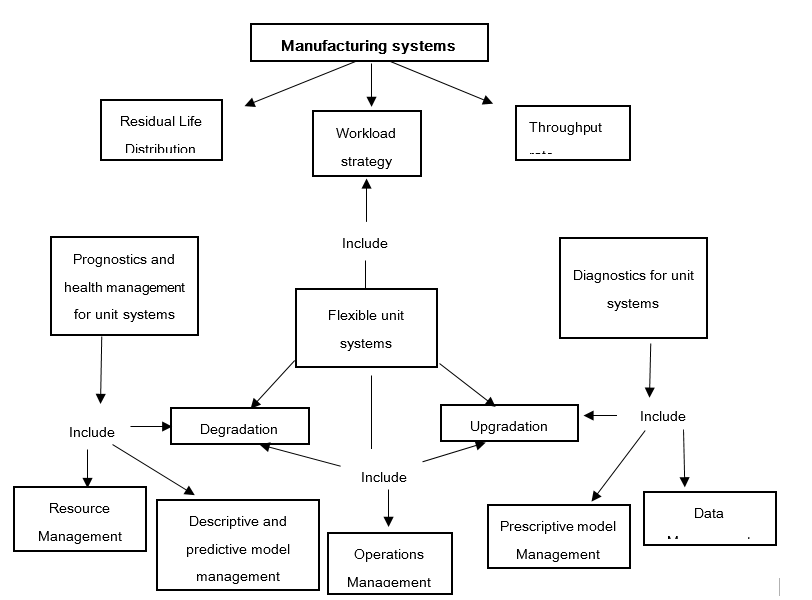
| Version | Summary | Created by | Modification | Content Size | Created at | Operation |
|---|---|---|---|---|---|---|
| 1 | Leonilde Varela | + 1502 word(s) | 1502 | 2021-03-02 04:02:48 | | | |
| 2 | Bruce Ren | -22 word(s) | 1480 | 2021-03-10 11:19:35 | | |
Video Upload Options
Research on flexible unit systems (FUS) with the context of descriptive, predictive, and prescriptive analysis have remarkably progressed in recent times, and is now reinforced in the current Industry 4.0 era with the increased focus on the integration of distributed and digitalized systems.
1. Introduction
Recently, the manufacturing systems domain underwent a paradigm shift by introducing several key enabling technologies as a requirement of Industry 4.0 [1]. Keeping in mind clients’ customized requirements and global manufacturers’ personalized production, the current production and process capabilities need to be transformed. For example, recent requirements such as shorter product life cycles, high production rates, jobs complexity, quality products, and cost-effectiveness are the most significant factors for any manufacturing industry [2]. Considering all the foregoing requirements, and, in addition, according to with the current market demand and society requests, there is a need to enhance the system’s capabilities by maintaining it under control from system breakdowns and several external forces that have not been considered as one of the highest priority in the past decade. To accomplish these challenges, there is a need for high machine availability, flexibility, configurability, and accessibility of manufacturing processes, as mentioned in [3][4][5][6][7][8][9]), along with another interesting contribution for emphasizing the necessity of increasing the level of flexibility of manufacturing systems, which can be seen in https://publications.muet.edu.pk/index.php/muetrj. However, various manufacturing systems available to fulfil the above-mentioned requirements have costs affairs and high maintenance. In this review paper, we introduced a special kind of configuration: i.e., flexible unit systems (FUS) with one degree of flexibility, two degrees of flexibility, semi flexibility, and highly flexible configurations, where the reconfiguration and upgradation of unit (machine) systems are easily achieved [10][11].
The common factors from different studies that affect FUS are identified as degradation rate, residual life distribution, workload strategy, upgradation, and predictive maintenance. To improve the health status of the system and to make the manufacturing functions effective and efficient, system-level health monitoring is new thinking to which nowadays researchers are paying attention. Therefore, the degradation rate at the system level is of the highest priority. Studies have shown that manufacturing systems are subjected to degradation both with age and usage, including wear, cracking, and fatigue, among others; whereas the residual life of a machine was characterized as remaining useful till its level of degradation arrives at a predefined failure threshold [12]. Real-time production data from complex systems produce a huge variety and volume of data. Handling this kind of data-intensive system with conventional statistical tools may be insufficient when firms seek to strategically conceal the data [13]. Hence, there is a need for advanced analytics such as descriptive, predictive, and prescriptive analytics to analyze the machine’s historical data to improve the efficiency of the system by knowing the health condition at every stage.
Given this scenario, towards summarizing the status of present research and to stimulate future investigations, the main aim of this paper is to carry out a Systematic Literature Review (SLR) with respect to the degradation and upgradation models for FUS. Hence, a review of manufacturing systems in the context of three analytics has been considered, particularly with flexibility as a key common word. The analysis of the reviewed literature enabled us to develop a comprehensive conceptualization as shown in (Figure 1). It is the conceptualization that was used to classify the findings and it was also referenced for future research.
Figure 1. Framework addressing the topics affecting flexible unit systems (FUS).
2. Discussion and Future Research Agenda
This paper presents the SLR using different articles to discuss degradation and upgradation models for flexible unit systems life. Some significant issues from the review are talked about in this section. Moreover, there is an opportunity to identify the number of research gaps, with suggestions for future work. The discussion follows the conceptualization that appeared in Figure 1. First, the 5 keywords that have been taken into consideration are (1) Degradation, (2) Residual life distribution, (3) Workload adjustment, (4) Upgradation, and (5) Predictive Maintenance. The keywords have helped us to find related journal articles by searching in the three databases in the selected research area. Authors such as [14][15] discussed different analytic techniques, for example, descriptive, predictive, and prescriptive, to analyze manufacturing data for achieving competitive benefits for the manufacturing industries.
Authors Hao et al., Ben-Salem et al. [16], Peng et al. [17], Bian et al. [18], and Hajej et al. worked on the degradation of different configurations, for example, series and parallel configuration manufacturing systems. Zhenggeng et al. worked on degradation models and various stochastic processes like gamma process and Markov renewal process to find the degradation rate of manufacturing equipment. Zhang et al. proposed conventional Wiener process-based degradation as one of the most important degradation model techniques among different degradation techniques. Naipeng et al. [19], Das et al, Si et al., Zhang et al., and Bian et al. worked on finding the relationship between degradation rate and the residual life of a machine. The prediction of the manufacturing unit’s residual life will be helpful to reduce the degradation rate by adjusting the workload to maintain the maximum production rate.
Adam Robinson, Pavlov et al., Garcia-Garza et al., Grohn et al., Du et al., Menezes et al., and Dong et al. investigated upgradation of a manufacturing system, which will help to enhance the performance and reliability of manufacturing equipment. Spendla et al., Dong et al., Fang et al., and Kaiser et al. [20] present the predictive maintenance of machines using sensors degradation data for calculating the time to failure of various machines. Traini et al., Zhang et al., and He et al. worked on predictive maintenance analytics by considering recent past data to eliminate prospective failures and also to improve the mission dependability of production systems.
2.1. Research Opportunity 1: How Can Residual Life Be Predicted in FUS to Improve Systems Efficiency
Degradation is an unavoidable characteristic, which it requires the utmost attention to pursue. However, a lot of literature is already available to handle the degradation rate at the component level. A limited number of papers (Hao et al.; Manupati et al.) have considered system-level degradation, especially in the manufacturing systems context. A recent paradigm shift has forced the use of the Internet of Things (IoT) in almost every stage of the product life cycle. In addition, process industries have highly benefitted from the key technologies that emerged from this shift (Varela et al., [21] Varela and Ribeiro,) [22]. To make these processes effective and efficient, system-level health monitoring is new thinking among researchers paying attention to these issues. To improve the health status of the system, an individual system’s degradation rate needs to be decreased, which in turn improves the residual life of the machine. Here, the residual life of a machine was characterized as remaining useful time till its level of degradation arrives at a predefined failure threshold. The degradation and residual life follow different distributions depending on the order requirement and system status. Hence, this is a challenging work one can take into consideration to explore further.
2.2. Research Opportunity 2: How to Deal with Heterogeneous Data Obtained from Various Sensory Sources for Predicting the Degradation Rate of FUS?
Heterogeneous data includes multiple internal and external databases generated from different sources obtained in various dimensions (Varela and Silva, 2008 [23], Zhang and Gregorie, 2016) [75]. Real-time production data from complex systems produce a huge variety and volume of data. Handling these kinds of data-intensive systems with conventional statistical tools may be insufficient when firms seek to strategically conceal the data [24][25][26][27]; Hence, to handle the heterogeneous data in FUS and predict the degradation rate, improving the residual life advanced analytics is essential. This area opens wider challenges for the researchers to explore.
2.3. Research Opportunity 3: How to Develop FUS for Real-Life Problems?
In this section, we propose four different configurations derived from the real-life examples: i.e., one degree, two-degree, semi-flexible, and fully flexible, shown in Figure 2a–d. Where one-degree configuration is represented, it handles the requirements to process it in sequential order. The open braces (1, 1) represent the position and stage of the machine, e.g., (1, 4) in Figure 2a. Consequently, for two degrees of flexibility, the configuration is shown in Figure 2b, through which, after the jobs arrived and processed in the first machine are chosen for the next operation to process on the second machine, it has a flexibility of alternative machines available in the second position at the second stage. Hence, it has position flexibility, routing flexibility, and machine flexibility to execute the operations. Figure 2c,d represents the semi-flexible and fully flexible unit system, wherein in the semi-flexible configurations, the second operation can be processed on more than 2 machines unlike the restrictions presented in the previous systems. In the fully-flexible systems, the machines have the flexibility to process any operation at a time.
 |
 |
|
(a) One-degree flexible configuration |
(b) Two-degree flexible configuration |
 |
 |
|
(c) Semi-flexible configuration |
(d) fully flexible configuration |
Figure 2. A flexible unit system with different configurations.
References
- Sima, V.; Gheorghe, I.G.; Subić, J.; Nancu, D. Influences of the Industry 4.0 Revolution on the Human Capital Development and Consumer Behavior: A Systematic Review. Sustainability 2020, 12, 4035, doi:10.3390/su12104035.
- Lenz, J.; Pelosi, V.; Taisch, M.; MacDonald, E.; Wuest, T. Data-driven Context Awareness of Smart Products in Discrete Smart Manufacturing Systems. Procedia Manuf. 2020, 52, 38–43, doi:10.1016/j.promfg.2020.11.008.
- Ashraf, M.; Hasan, F. Configuration selection for a reconfigurable manufacturing flow line involving part production with operation constraints. Int. J. Adv. Manuf. Technol. 2018, 98, 2137–2156, doi:10.1007/s00170-018-2361-7.
- Antosz, K.; Ratnayake, R.C. Spare parts’ criticality assessment and prioritization for enhancing manufacturing systems’ availability and reliability. J. Manuf. Syst. 2019, 50, 212–225, doi:10.1016/j.jmsy.2019.01.003.
- Gola, A. Reliability analysis of reconfigurable manufacturing system structures using computer simulation methods. Ekspola-tacja Niezawodn. 2018, 21, 90–102, doi:10.17531/ein.2019.1.11.
- Wei, Y.; Wu, D.; Terpenny, J. Decision-Level Data Fusion in Quality Control and Predictive Maintenance. IEEE Trans. Autom. Sci. Eng. 2020, 18, 1–11, doi:10.1109/tase.2020.2964998.
- Gbadamosi, A.-Q.; Oyedele, L.O.; Delgado, J.M.D.; Kusimo, H.; Akanbi, L.; Olawale, O.; Muhammed-Yakubu, N. IoT for predictive assets monitoring and maintenance: An implementation strategy for the UK rail industry. Autom. Constr. 2021, 122, 103486, doi:10.1016/j.autcon.2020.103486.
- Paolini, G.; Guermandi, M.; Masotti, D.; Shanawani, M.; Benassi, F.; Benini, L.; Costanzo, A. RF-Powered Low-Energy Sensor Nodes for Predictive Maintenance in Electromagnetically Harsh Industrial Environments. Sensors 2021, 21, 386, doi:10.3390/s21020386.
- Jasiulewicz-Kaczmarek, M.; Żywica, P.; Gola, A. Fuzzy set theory driven maintenance sustainability performance assessment model: A multiple criteria approach. J. Intell. Manuf. 2021, 1–19, doi:10.1007/s10845-020-01734-3.
- Denyer, D.; Tranfield, D. Producing—A Systematic Review. 2009. Available online: https://psycnet.apa.org/record/2010-00924-039 (accessed on accessed on 11 August 2020).
- Svetlík, J. Modularity of Production Systems. In Machine Tools: Design, Research, Application; IntechOpen: London, UK, 2020.
- Hao, L.; Liu, K.; Gebraeel, N.; Shi, J. Controlling the Residual Life Distribution of Parallel Unit Systems through Workload Adjustment. IEEE Trans. Autom. Sci. Eng. 2015, 14, 1042–1052, doi:10.1109/tase.2015.2481703.
- Zhang, J.; Liu, X.; Li, X.-B. Predictive Analytics with Strategically Missing Data. INFORMS J. Comput. 2020, 32, 1143–1156, doi:10.1287/ijoc.2019.0947.
- Djelloul-Khedda, Z., Boughrara, K., Dubas, F., & Ibtiouen, R. (2017). Nonlinear analytical prediction of magnetic field and electromagnetic performances in switched reluctance machines. IEEE Transactions on Magnetics, 53(7), 1-11.
- Iftikhar, N.; Baattrup-Andersen, T.; Nordbjerg, F.; Bobolea, E.; Radu, P.-B. Data Analytics for Smart Manufacturing: A Case Study. In Proceedings of the 8th International Conference on Data Science, Technology and Applications, Prague, Czech Republic, 26–28 July 2019; pp. 392–399.
- Ben-Salem, A., Gharbi, A., & Hajji, A. (2015). Environmental issue in an alternative production–maintenance control for unreliable manufacturing system subject to degradation. The International Journal of Advanced Manufacturing Technolo-gy, 77(1-4), 383-398.
- Peng, W., Li, Y. F., Yang, Y. J., Huang, H. Z., & Zuo, M. J. (2014). Inverse Gaussian process models for degradation analysis: A Bayesian perspective. Reliability Engineering & System Safety, 130, 175-189.
- Bian, L., Gebraeel, N., & Kharoufeh, J. P. (2015). Degradation modeling for real-time estimation of residual lifetimes in dy-namic environments. Iie Transactions, 47(5), 471-486.
- Li, N., Gebraeel, N., Lei, Y., Bian, L., & Si, X. (2019). Remaining useful life prediction of machinery under time-varying oper-ating conditions based on a two-factor state-space model. Reliability Engineering & System Safety, 186, 88-100.
- Kaiser, K.; Gebraeel, N. Predictive Maintenance Management Using Sensor-Based Degradation Models. IEEE Trans. Syst. Man Cybern. Part A Syst. Hum. 2009, 39, 840–849, doi:10.1109/TSMCA.2009.2016429.
- Varela, M.L.R.; Putnik, G.D.; Manupati, V.K.; Rajyalakshmi, G.; Trojanowska, J.; Machado, J. Collaborative manufacturing based on cloud, and on other I4.0 oriented principles and technologies: A systematic literature review and reflections. Manag. Prod. Eng. Rev. 2018, 9, 90–99, doi:10.24425/119538.
- Varela, M.L.R.; Ribeiro, R.A. Distributed Manufacturing Scheduling Based on a Dynamic Multi-criteria Decision Model. In Algorithms as a Basis of Modern Applied Mathematics; Springer: Cham, Switzerland, 2014; Volume 317, pp. 81–93.
- Varela, M.L.R.; Silva, S.D.C. An Ontology for A Model of Manufacturing Scheduling Problems to Be Solved on the Web. In New Trends in Nonlinear Control Theory; Springer: Cham, Switzerland, 2008; Volume 266, pp. 197–204.
- Ye, Z.; Cai, Z.; Zhou, F.; Zhao, J.; Zhang, P. Reliability analysis for series manufacturing system with imperfect inspection considering the interaction between quality and degradation. Reliab. Eng. Syst. Saf. 2019, 189, 345–356, doi:10.1016/j.ress.2019.05.005.
- Varela, M.L.R.; Putnik, G.D.; Cruz-Cunha, M.M.; Cruz-Cunha, A.M.M. Web-Based Technologies Integration for Distributed Manufacturing Scheduling in a Virtual Enterprise. Int. J. Web Portals 2012, 4, 19–34, doi:10.4018/jwp.2012040102.
- Arrais-Castro, A.; Varela, M.L.R.; Putnik, G.D.; Ribeiro, R.; Dargam, F.C.C. Collaborative Negotiation Platform Using a Dy-namic Multi-Criteria Decision Model. Int. J. Decis. Support Syst. Technol. 2015, 7, 1–14, doi:10.4018/ijdsst.2015010101.
- Vieira, G. G., Varela, M. L., Putnik, G. D., & Machado, J. (2018). Intelligent Platform for Supervision and Production Activity Control in Real Time. In Advances in Manufacturing, 151-159, Springer. DOI: 10.1007/978-3-319-68619-6_15.





